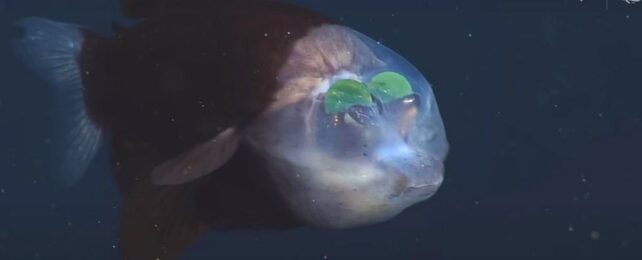While it's very true that, as the great Ian Malcolm once said, "life finds a way," that way can sometimes veer quite far off the beaten path.
One of the most beautiful and strange examples of this is the Pacific barreleye fish (Macropinna microstoma), small fish that live in the twilit ocean at depths of 600 to 800 meters (2,000 to 2,600 feet).
Most animals with eyes have their peepers just sitting somewhere on the surface of their faces, but the barreleye is very different. Its eyes are in its face, two tubular eyes topped with extremely light-sensitive domes, pointing upwards, and encased in the fluid-filled, transparent cockpit of its forehead.

There's a lot we don't know about these mysterious fish. We don't know how they reproduce, for example. Many scientific drawings over the years didn't include the dome, since the family was known from samples that had been removed from the ocean, probably destroying the delicate dome in the process.
It had also been assumed by scientists for many years that the fish's eyes were fixed in position, like the tubular eyes of owls; it wasn't until 2009 that we discovered that it could also point its eyes forwards.
Those eyes are a powerful tool for barreleyes. They have a large lens and a large number of rod cells (and no cones). The transparent dome likely protects the eyes from the stinging cells of the animals on which they prey, as well as collecting more light – a bit like a magnifying glass.
Two other species of barreleye, Rhynchohyalus natalensis and Dolichopteryx longipes, are the only known vertebrates that use a mirror to focus their eyes.

Only a small amount of light penetrates the water to reach the depths where they live. They peer upwards through the water column to make the most of that light, to catch glimpses of predator and prey.
They have flat fins that allow precision maneuvering; they're even able to 'hover' motionless in the water. Their tiny mouths indicate precision feeding, but they have a large digestive system capable of handling a wide variety of drifting prey, from plankton to jellies to crustaceans.
These little fish are only ever encountered vanishingly rarely on ocean expeditions. Yet everything we know about them suggests that they are tenacious little survivors, making the most of their strange existence in the eerie darkness.
